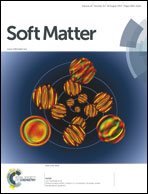pH-control of the protein resistance of thin hydrogel gradient films†
Abstract
We report on the preparation and characterization of thin polyampholytic hydrogel gradient films permitting pH-controlled protein resistance via the regulation of surface charges. The hydrogel gradients are composed of cationic poly(2-aminoethyl methacrylate hydrochloride) (PAEMA), and anionic poly(2-carboxyethyl acrylate) (PCEA) layers, which are fabricated by self-initiated photografting and photopolymerization (SIPGP). Using a two-step UV exposure procedure, a polymer thickness gradient of one component is formed on top of a uniform layer of the oppositely charged polymer. The swelling of the gradient films in water and buffers at different pH were characterized by imaging spectroscopic ellipsometry. The surface charge distribution and steric interactions with the hydrogel gradients were recorded by direct force measurement with colloidal-probe atomic force microscopy. We demonstrate that formation of a charged polymer thickness gradient on top of a uniform layer of opposite charge can result in a region of charge-neutrality. This charge-neutral region is highly resistant to non-specific adsorption of proteins, and its location along the gradient can be controlled via the pH of the surrounding buffer. The pH-controlled protein adsorption and desorption was monitored in real-time by imaging surface plasmon resonance, while the corresponding redistribution of surface charge was confirmed by direct force measurements.


 Please wait while we load your content...
Please wait while we load your content...